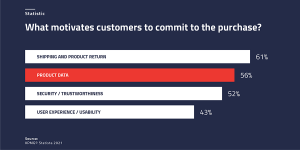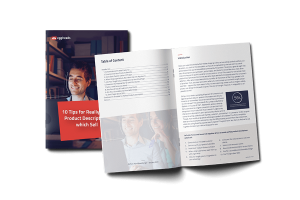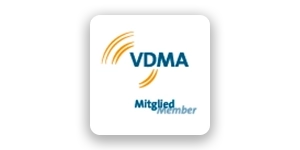Product Communications
We Reveal the Secrets of Successful E-Commerce Product Pages

Content
What Defines Really Good Product Pages?
A good online shop must offer its customers everything a physical shop has in store: great product advice and all relevant product information at a single glance. In webshops, however, visitors can neither touch nor examine the product. So, it’s all the more important that your digital product presentation provides consumers with an extra little something. This includes target-group-oriented texts, product descriptions, images, videos, and supplementary content.
However, what do consumers value in particular? And how can your page content be optimized accordingly? You can find the answers to these questions in today’s blog entry.
What motivates customers to commit to the purchase?
How can users be converted into customers? Statista has surveyed this question in 2021 and came to the following results:
1st Place. Shipping and product return (61 %)
2nd Place. Product data (56 %)
3rd Place. Security / trustworthiness (52 %)
4th Place. User Experience / usability (43 %)
Shipping and product returns are valued the most by users. You may already know why: One click, and we’ve got one pair of shoes too much in our shopping bin, and only after seeing them live and in color do we second-guess our own choice. In this use case, it’s a massive motivator for the purchasing decision if the payment can be delayed until trying things on yourself or if the product return is free of charge.
💡 Our tip: Make it easy for your customers and offer simple shipping and return options.
Good product data is ranked second with 56 percent. What kind of data you need varies from target group to target group and from product to product. There are emotional products which are best presented with images, videos, and semantic texts. Then there are products where technical specs presented in a clean table for quick comparison are decisive.
💡 Our tip: Work a bit on your relationship with your product data. With well-structured data, the optimization of your product pages and online shop will be a sure-fire success. If all important information about a product is immediately available at a glance, you’ve already made a large step towards better data. A PIM system facilitates your work on product data immensely.
Security and trustworthiness occupy the third place with 52 percent. For example, popular shop rating platforms are Idealo, Trusted Shops certificates, or the payment option PayPal. Good references and positive reviews contribute to the credibility of your store.
💡 Our tip: Animate happy customers to write reviews about your online shop. Good references strengthen the trust into your product and brand, hereby contributing to the optimization of your product pages.
User experience and usability take the fourth place with 45 percent. This includes feats such as Mobile First, search functions with filters and sorting, as well as a wishlist gadget. Responsive Design is crucial if the target groups who access your product pages are vivid smartphone or tablet users. Keep in mind: Nowadays, we do our weekend shopping directly from the couch or on the way back from work in the subway – it’s handy, quick, and comfy. Mobile First is today’s be all and end all. This applies to any website. Especially when it comes to the rankings of search engines such as Google. If your site isn’t optimized for mobile devices, it ranks lower in the Google ranking.
For optimizing your product pages, filters are key. Context-sensitive filters help users to find their desired product much quicker. Categories guarantee that your product portfolio is browsable at the click of a button for better usability. Regardless of what product you’re selling – be it fashion, tools, or food. Additionally, you can positively surprise your visitors with supplementary content. For example, if your users categorize by veggies, you can also provide them with some context-sensitive tips for healthy nutrition. Combine this with a link for purchasing tomatoes – and don’t forget about the Call to Action, “Add to Shopping Bin” to top things off. Search and filter functions always pay dividends when you’re also offering spare parts, accessories, or synergizing products; and when you want to assure your users that products or spare parts are, indeed, compatible with one another.
The sorting function is usually used to find new products or attractive deals. Even wishlists and wedding lists are considered standard among some of today’s shop operators. Users often times save their wishes for the next visit. Afterwards, the list is shared with friends so that they don’t get yet another candlestand for X-Mas.
Now, that’s the theory – but how is the optimization of product pages carried out in real-case scenarios? Unfortunately, there’s no ready-made recipe for success – there’s neither a smart marketing gimmick nor a perfect template. The e-commerce industry is simply to vast and diverse. However, don’t surrender just yet. Our experience has shown that product pages can be optimized with little to no effort if you refer to the following questions as your guideline.
The Question of All Questions concerning Successful Product Pages
What defines my product?
- Unique selling points (USPs) like quality, price, or special functionalities are exciting criteria for target groups of your product pages.
- Good service gives your users a feeling of security and directly influences their purchasing decision.
- Positive feedback and experience reports by customers are, to many, decisive when committing to online purchases.
- Sustainability and ecological footprints are aspects which are gaining in significance nowadays. The eco-industry has grown immensely over the last few years.
What problems does my product solve?
Do consumers search for a product or do they search for solutions to their problems? We can illustrate this question rather intuitively with an example which keynote speaker and author Hendrik Lennarz has provided during his eggheads day 2021 session:
You may be able to come up with an adequate and precise technical name for your highly specific product. Yet, at the end of the day, what consumers enter as search terms are problems and solutions. Have you heard about the brannock device? It’s the tool used to measure the size of your foot when buying shoes at a physical footwear store. Everybody has seen it at least once in their life. However, if you were to search for it online, you’d rather refer to it via descriptors such as “device for measuring foot,” would you not? The good news is: You can define identifiers which are only used as SEO-relevant search terms without displaying them directly on your product page, hereby avoiding unnecessary clutter.
What benefits does my product offer to users?
Why should visitors of your shop pages buy your product? Why not your competitor’s? It’s important to clearly highlight the benefits your product brings to the table. Is your product faster than other models? Does it have a better performance? Preferably, you can highlight benefits and improvements in the form of a product comparison. The battery may have more storage capacity or the flashlight may shine brighter than older models. You know that you’ve got a good product to offer – it’s about proving it to the rest of the world!
In what kinds of use contexts is my product utilized?
Use case descriptions are indispensable – in particular if the use case context isn’t immediately intuitive at first glance. If your target group would need to refer to additional sources via Google to figure out what exactly your product is used for, then this is a clear indicator for unclarity and complexity that could’ve been avoided. As a consequence, your visitor may cancel her purchasing decision. In order to present complex products in a user-friendly manner, videos, detail images, and an additional download center are recommended.
Configurators are also a good option when it comes to making your product feel alive and plastic in the customer’s mind. Usually, configurators are implemented if your product offers a great many combination options. Complex configurations can be found, for example, in the furniture industry for setting up customized kitchens or living rooms. Even simple product configurators can do the trick. Apple, for instance, provides you with the option to configure your smartwatch online – you can choose freely between your favorite color, material, size, connectivity, and the right wristband to match. And then you can hit the nearby order button.
How do customers search for my product?
The search is a complex topic. You’ll have to factor in a lot of search mechanisms. And there are many ways which may lead target groups to your product. In the best-case scenario, you can provide context-sensitive information for each option. All possible search criteria can be linked to your product as information and used for the search. Not all information needs to be displayed visually – as we’ve already discussed in the context of the “brannock device” above. The search my still include data that’s not visible to page viewers or may even exclude information that’s directly displayed on the page. For some shop operators, it may even come in handy to have the article number of rival products assigned so as to display them in the hitlist.
What does my customer need to make an informed purchase decision?
Ideally, you have an express shipping option with an estimate of the delivery date and a free product return option. Even the stock count can have a psychological effect on our purchase decision: if there are only a few units left, we’re more willing to commit to the purchase. We become worried that other people may snatch the last remaining article from under our nose.
Customers are to be convinced by the product and a good product description. Furthermore, it’s important to establish trust and provide a sense of security, be it in form of customer reviews, eco-seals, Trusted Shops, secure payment methods like PayPal, or many other options. Your shop should be both functional (Usability) and clean (User Experience), so that consumers enjoy exploring your product offer and, eventually, find the product they do want.
In online retail, prices have become transparent more than ever. You can compare prices across platforms with Idealo or other services. Customers can even check the price development and set up a price alarm. Also, such web services even come with shop review features – try to collect good reviews for your shop and strengthen the trust of your customers. Depending on the website, the customer may not even need to leave the price comparison platform to buy the product directly.
If the target groups allow for it, you should also supply such platforms with your product and your own data for maximum market expansion.
Who even is my customer?
Product pages should address your target group with relevant content. Reflect on the needs and to-be-tackled challenges of your target group, which parts of the internet they frequent, and which content you want to provide to them during each individual step in their Customer Journey.
A target group from the B2B sector is usually active on social media channels such as LinkedIn and Snapchat. Also, you’ll need to conform to industry standards such as ETIM, ECLASS, and BMEcat, or directives in order to supply their delivery systems.
If you’re targeting the B2C markets for customers younger than 30, you may want to consider presenting your product on hip platforms such as TikTok or Instagram.
It’s imperative to determine where exactly your target group shops, what they buy, and how they come to form their purchasing decision. How do they search for products and what criteria do they look out for? Equipped with this information, you can present your product in the best possible light for your target groups.
The Must-Haves for Perfect Product Pages
Of course, the must-haves for optimal pages differ from use case to use case. The online retail sector is as multifaceted as its customers. For this reason, no universally applicable recommendations can be handed out prior to a detailed analysis. Yet still, throughout our years’ worth of experience, we’ve managed to distill the following six elementary must-haves which all good product pages have in common – regardless of your industry sector.
Visual Data: Product images from different angles, technical drawings, videos etc.
Product Descriptions: Expressive, detailed, unique, personalized or target-group-oriented content
Cross-sell/Up-sell: Connecting products – accessories, spare parts, sets, recommendations, and similar products
User Content: Experience reports, feedback, reviews, selfies with the product, use cases ideas, etc.
Decision Support: Comparison options, search bars, filters, live chats, chat bots, goodie popups, product return options, etc.
Mobile First: Content specifically optimized for mobile devices – accessible from anywhere at anytime
This is How You Can Realize Measures with Little Effort
There are a lot of starting points when it comes to optimizing your page content. What may sound like a lot of work at first will pay back tenfold. Since a good product rate translates into a good conversation rate and generates more sales. The basis of all this is your product data and data quality. Only consistent data allows you to realize all subsequent improvements. And our software is the optimal support when it comes to data quality without the need to invest a large quantity of human resources.
These are the Functions with which eggheads Suite can Support You:
- Translations
AI-based translations with DeepL or machine-assisted translations based on already translated segments provide the foundation for good translation quality. You can connect eggheads Suite to your Across TMS tool to automate parts of your translation management either in-house or in collaboration with translation agencies. - Keywords
Automatic keyword generation for assets is already common practice thanks to developers such as Canto Cumulus. Here, too, our PIM system provides you with an intersection node for full connectivity. - Data Pools
Your central data model in eggheads Suite can be enriched with data pools from icecat, GDSN, Giata, or other providers. - Classifications
Products and assortments can be managed in eggheads Suite with user-defined product attributes, texts, values, and units for data consistency without redundancy. This makes similar products from different manufacturers comparable with one another across the board – and you can supply even price comparison portals frequented by your target groups via your single source of truth. - Terminology
Automated text generation, even for complex semantic texts (e.g. Retresco or Aexea), are supported by our PIM. - Omni-Channel
All relevant marketing and sales channels can be supplied with non-redundant data from eggheads Suite. Even filling your social media channel poses no challenge.
Top-Maintained Product Data!
From Our Blog
You may also be interested in the following articles









